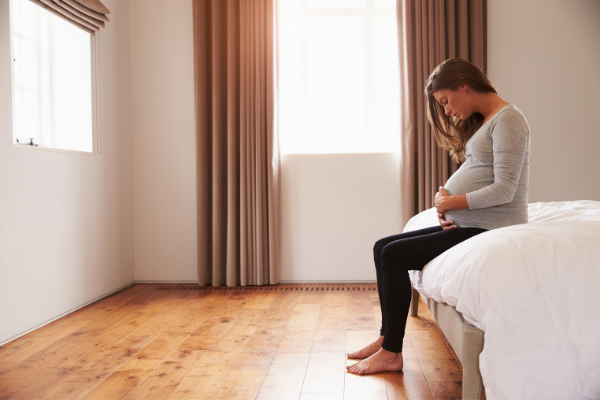The Easy Way to Prepare your Baby to “Spring Forward” for Daylight Savings Time
Disclosure: This post may contain affiliate links and I may earn a small commission when you click on the links at no additional cost to you. As an Amazon affiliate I earn from qualifying purchases. You can read the full disclaimer here.
Hooray! Spring is right around the corner! But, (boo…) so is the time change. You’re sleep-deprived enough as it is, I know! And the loss of that precious hour is going to be even harder on your baby if she’s not prepared.
When my preschooler misses a nap or has a rough night of sleep, I know she’s going to be moody, have a hard(er) time paying attention to simple tasks, and want to eat evvvverything in the pantry and none of her dinner.
The great news is: there’s no need to “spring” the time change on her! Here’s the simplest way to adjust your baby’s schedule NOW so that she won’t even notice the day you move those hour-hands forward.
Give yourself some time
You can choose to implement this method either leading up to the day of the time change, or following after, or a little of both! Whatever is easiest for your household. Either way, give yourself and your baby about 7-8 days to make the adjustment gradually.
Remember that Daylight Savings Time always takes place on a Sunday. So personally, I like to save the biggest adjustment (the seventh day) for the day before, which is a Saturday when I know I’ll have my husband’s help. That means starting these adjustments eight days prior to the time change, which this year (2022) will be Saturday, March 12.
Take it one step at a time
Every other day, begin your baby or preschooler’s normal schedule of activities 15 minutes earlier. That includes both going to bed and waking up, mealtimes, naptimes and whatever other anchors normally pepper their day.
For example, let’s say bedtime is normally around 7pm. Starting eight days prior to the time change, make bedtime happen around 645pm instead. Then two days later, put the kids to bed around 630pm. In another two days, make it 615pm.
On the seventh day, you’ll be putting them to bed at 6pm, which will seem ridiculously early! But trust me… on the eighth day – if you have timed it right, that will be Sunday, March 13 (in 2022, at the time this article is being written) – you will be putting them to bed right on time at 7pm again, without them having missed a beat!
Implement the same adjustments for mealtimes and wake times. Of course, if your kids are anything like mine, they’re already pretty reliably early on the wake times. (Solidarity, mama. And all the caffeinated vibes.)
Show them a good time
For preschoolers learning how to tell time on an analog clock, this presents an excellent teaching moment! Add colorful post-it note flags to the minute-hand and four quarters of the clock to help your young child understand when the schedule is going to change to each day.
You can advance the lesson by writing the days of the week that each schedule change will happen. If you start eight days prior to DST, the 3 on the clock will sport a “Sunday & Monday” tag, the 6 will have a “Tuesday & Wednesday” tag, the 9 will have a “Thursday & Friday” tag, and the 12 will have a “Saturday” tag.

Like this post? Why not try…
My Top 3 Secret Weapons! How to Prevent Diaper Rash
… because an ounce of prevention is worth a pound of cure!
Time the lights
Keep your daily routines the same, but use lighting to help signal when those routines are to begin each day. Start closing blinds (we love using these thermal darkening curtains!) and dimming the lights about 30 minutes prior to their prescribed bedtime. This helps send a biological message to their bodies that sleepytime is imminent, no matter what the clock says.
Likewise, ensure that they get some natural sunlight exposure with breakfast. If the weather permits, consider opening up the windows to let in some fresh air! Let nature’s own goodness alert their bodies to the time adjustment.
Remember to also fine-tune their permission to use electronic devices accordingly. Blue light exposure from the television, cell phones, tablets, and computers engages the brain and sends a false signal to be alert, wrecking sleep time and quality.
Keep an eye on the time
Remember to get ahead of this adjustment in the fall! Daylight Savings Time this autumn will happen on Sunday, November 6, 2022. So go ahead and mark it on your calendar now so that it won’t sneak up on you and your littles.
Give yourself some grace too. Although you’ll be tempted to “make good use” out of the extra minutes you’ll have once the kids are in bed, consider that those same minutes will still be missing the next morning. So you try to get some shut-eye too!
After all, a well-rested Mama not only sets a good example, but has better ability to handle every day’s curveballs without irritation and sluggishness.
The Bottom Line
Just remember that, no matter how you slice it, everyone will ultimately adjust. Even if you forgot about it until the last-minute, things will feel back to normal in about a week. Until the powers-that-be decide to quit messing with the clocks twice a year, take each season as it comes, breathe, and be thankful for the time you have with one another.
Let’s continue the conversation! Join us in the comments below, and tell me some of your favorite tips and tricks for getting the kids ready to adjust to Daylight Savings Time.




